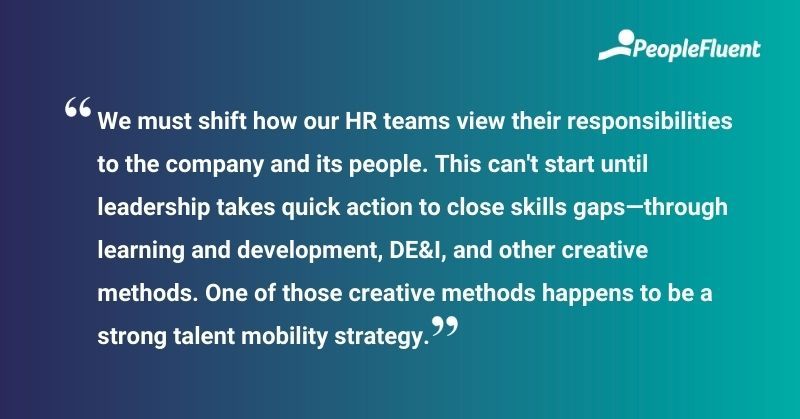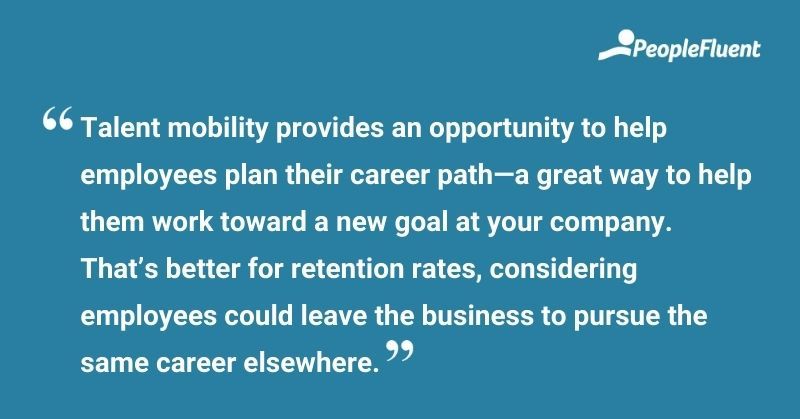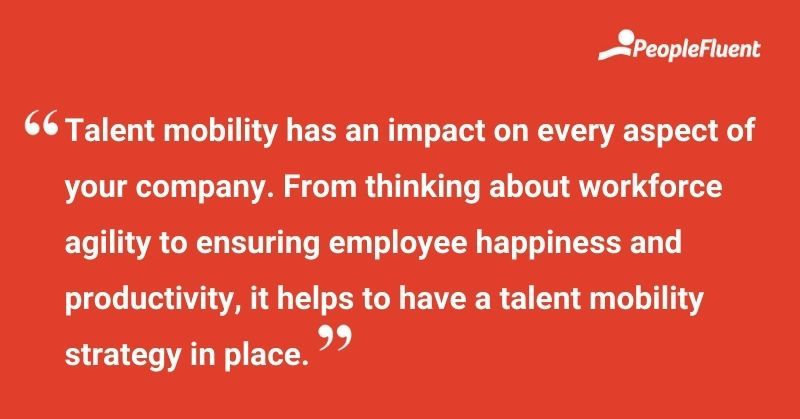Published: Oct 11, 2021Time to read: 6mins Category: Insights
Working Together: How Talent Mobility Influences Employee Experience (And Vice Versa)
Table of Contents
With research showing that more than 40% of U.S. workers changed jobs, managers, or roles in 2020, organizations can expect continued change. But don’t panic! By focusing on a talent mobility strategy, you can create a better employee experience—no matter where your people are working from.
The skills gap is getting wider and companies need a plan to address it. Over the last few years, artificial intelligence and other tech advancements have influenced how we work. Now, we must also shift how our HR teams view their responsibilities to the company and its people. That means going beyond recruiting and retaining talent—HR folks need to deepen their collaboration with L&D and line managers.
None of this can start until leadership takes quick action to close skills gaps—through learning and development, DE&I, and other creative methods. One of those methods happens to be a strong talent mobility strategy. Yet, companies still find many barriers to rolling out a talent mobility program.
So, what can we do? For starters, figure out what gaps exist and how your HR perspective should shift to provide a better employee experience. Keep reading to discover how talent mobility can help you do just that!

YOU MIGHT ALSO LIKE | ‘What Is Talent Mobility? Plus, What It’s Not!’
How Talent Mobility Benefits Your Employees
Are your employees interested in having the ‘right skills’? Skills that can set them up for a promotion in your organization? If so, this is where talent mobility comes in.
In today’s market, employees face many challenges. Remote working caused isolation and led to decreased productivity. It took a toll on mental health. Many people experienced burnout, decreased motivation and productivity, and a litany of other issues.
This all has a lasting impact on the individuals who make up our workforces. By giving people an opportunity to stretch their skills and learn new ones along the way you can increase overall job satisfaction. In turn, this boosts confidence in the employee and sets them up for future success. Embracing a talent mobility mindset is also an opportunity to help employees plan their career path—a great way to help them work toward a new goal while also increasing employee satisfaction. That’s better for retention rates and it keeps employees from leaving the business to pursue the same career elsewhere.
Other benefits include:
- Top performers can be more easily identified and rewarded
- Employees are more engaged in their work as they’re happier
- Employees feel inspired to continue learning and developing their skills/knowledge

ALSO READ | ‘Rise of the Modern Talent Journey: Mapping the New Employee Experience’
How Talent Mobility Benefits Your Organization
Are you looking for employees to join a project or move to a new role because you need internal expertise or a specific skillset? If so, you’re on the right track!
By establishing a strong internal mobility strategy, HR and hiring managers can easily identify the talent that exists in the business. It also helps the organization move people around the business for things like filling critical roles, stretch projects, and development of key strategic skillsets that are necessary to organizational success.
There are many benefits to aligning the right talent with the right role/project at the right time. By focusing on internal talent first, it will help you quickly fill roles with qualified candidates that already understand your business. It’ll also show you:
- Which roles your HR teams are having trouble filling with internal talent specifically
- Who has the interest, knowledge, and skills to step into a different role/path within the business
- What skills your organization needs and which ones can be developed with existing internal talent
- Which roles have historically been filled via internal mobility versus which roles have been externally filled
Internal mobility requires a culture of collaboration between current managers and hiring managers. Current managers who won’t let go of their top talent—as well as employees not knowing where open roles exist within the business—can be barriers.
While we might not be able to change your line manager’s mind about letting go of a top employee, talent mobility tech offers greater visibility into existing roles and opportunities. Technology can also help you create a pipeline of employees ready and willing to take the next step in their career—at your business, rather than a competitor’s.
RELATED READING | ‘How a Projects Marketplace Can Maximize Your Workforce Potential’
Focus on Organizational Design First, Tech Second
HR and L&D tech helped global workforces weather the sudden onset of remote working back in early 2020. However, being prepared with organizational design is really what helps companies overcome long-term, external pressure. That said, the right tech solutions will help you get through rapid shifts in the way we work.
It’s critical that managers and HR know where people are in the company and (more importantly) they must know the skills everyone has and which ones can be further developed. Talent mobility software can give you this visibility. But, if your organization lacks workflows and relies on senseless processes, what good is your tech?
Closing the skills gap is easier when you have deeper workforce analytics. Before digging into that data, you need to develop a framework for internal mobility so you better understand how to use those insights. This means making a serious investment in talent development. You don’t need to have skills already in place before you start developing your culture. Developing and/or recruiting internal talent is a great way to get this going. It starts with:
- Getting employees involved in exploring which paths they can take in your organization
- Understanding the employee’s interest and desire to move into a bigger/different role
- Understanding your employees and having open conversations about career pathing
- Continuing to add skills, abilities, and knowledge as employees develop their paths across the organization
You’ll also need to change your recruitment culture so managers look at internal talent when open roles become available. Ideally, before looking at external candidates. This practice is a winning strategy for creating a better employee experience.
At the end of the day, talent mobility has an impact on every aspect of your company. From thinking about workforce agility to ensuring employee happiness and productivity, it helps to have a talent mobility strategy in place.

Ready to enable your talent to develop the skills they need to remain productive and happy?
Let us help you take your talent mobility strategy from talk to action. Request a demo or talk with sales to find out how our talent mobility solutions can help your employees grow their skills and careers at your organization.